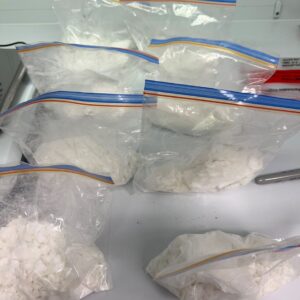Your cart is currently empty!
Fentanyl Powder – Research Grade
Research-grade fentanyl powder is designed for laboratory and experimental purposes. Ensures consistent quality and reliability. Fentanyl powder is a synthetic opioid known for its extreme potency, primarily used in medical settings for managing severe pain. It works by binding to opioid receptors in the brain, altering pain perception and sometimes inducing euphoria. Its high potency—50 to…
60 in stock
Description
Research-grade fentanyl powder is designed for laboratory and experimental purposes. Ensures consistent quality and reliability.
Fentanyl powder is a synthetic opioid known for its extreme potency, primarily used in medical settings for managing severe pain. It works by binding to opioid receptors in the brain, altering pain perception and sometimes inducing euphoria. Its high potency—50 to 100 times stronger than morphine—makes it effective for pain relief but also prone to misuse. Illicitly manufactured fentanyl powder has contributed to the opioid crisis, as it is often mixed with other substances, increasing the risk of overdose
Medical Applications
Fentanyl is a cornerstone in pain management, especially in cases of severe and unmanageable pain. Below are its primary applications:
- Surgical Use and Anesthesia:
- Fentanyl is often administered intravenously during surgeries as part of general anesthesia. It reduces pain sensation and provides sedation, enabling surgeons to perform procedures with minimal discomfort for the patient.
- It is used pre- and post-operatively to manage acute pain and ensure patient comfort.
- Cancer Pain Management:
- Fentanyl is highly effective for managing breakthrough pain in cancer patients. Breakthrough pain refers to sudden, intense pain episodes that occur despite ongoing pain control treatment.
- Formulations like lozenges, sublingual tablets, and nasal sprays are used for quick relief due to their rapid onset of action.
- Chronic Pain Relief:
- Patients with persistent and severe pain—such as those with musculoskeletal disorders or nerve-related pain—are prescribed fentanyl transdermal patches. These patches provide steady, controlled doses over an extended period (e.g., 72 hours), reducing the need for frequent dosing.
- Emergency Medicine:
- In emergency medical settings, fentanyl injections are used to quickly alleviate severe pain caused by injuries, trauma, or burns. Its fast action makes it invaluable in acute care environments.
- Palliative Care:
- Fentanyl is widely used in end-of-life care to improve the quality of life for patients with terminal illnesses. It offers effective pain relief and helps patients maintain dignity and comfort during their final stages.
Advantages in Medicine:
- Rapid onset of action due to its high lipid solubility, which allows it to cross the blood-brain barrier efficiently.
- Versatility in formulations, from injections to patches, enabling tailored treatment for various conditions.
- Efficacy in managing pain that is resistant to other opioids.
Societal Impact
While fentanyl is a vital medical resource, its societal impact is dual-edged due to the rise in misuse and illicit production:
- Opioid Epidemic:
- The misuse of fentanyl, particularly illicitly manufactured forms, has played a significant role in the global opioid epidemic. Its high potency makes it dangerous in non-medical contexts, where even tiny miscalculations in dosage can lead to overdose and death.
- Counterfeit pills containing fentanyl are often sold illicitly, with users unaware of the substance’s presence, contributing to accidental overdoses.
- Public Health Crisis:
- Fentanyl-related overdoses have reached alarming levels, especially in regions like the United States. Its presence in street drugs like heroin and cocaine has further exacerbated the crisis, as users unknowingly ingest lethal doses.
- Governments and healthcare systems are heavily burdened by the financial and resource demands of addressing the crisis, including rehabilitation programs, emergency interventions, and public health campaigns.
- Economic Costs:
- The economic toll of the fentanyl crisis includes healthcare expenses, lost productivity, and law enforcement efforts. Addressing the misuse of fentanyl requires significant investments in public health infrastructure.
- Harm Reduction Initiatives:
- Governments have implemented harm reduction strategies to combat the misuse of fentanyl, including increased access to naloxone (an opioid overdose reversal drug), educational campaigns, and prescription drug monitoring programs.
- Distribution of fentanyl test strips allows individuals to detect the presence of fentanyl in street drugs, potentially saving lives.
- Regulatory Measures:
- In response to the crisis, countries have tightened regulations on opioid prescribing and implemented strict controls on fentanyl production and distribution.
- International cooperation has also been critical in tracking and dismantling illicit fentanyl supply chains.
Balancing Benefits and Risks:
The societal impact of fentanyl underscores the importance of balancing its medical benefits with the risks of misuse. While it remains a critical tool in pain management, ongoing efforts to educate healthcare providers, patients, and the public are essential to mitigate its negative effects.







Reviews
There are no reviews yet.